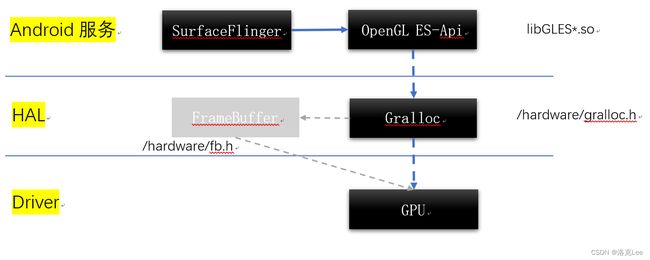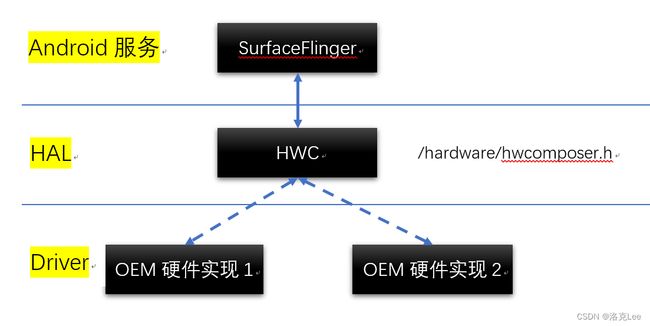Android SurfaceFlinger做Layer合成时,如何与HAL层进行交互
目录
- 零、本文讨论问题的范围
- 一、问题:SurfaceFlinger图层合成选择实现方式的两难
-
- 1.1 从OpenGL ES、HWC本身来讲
- 1.2 以HWC为主导的判断逻辑
- 二、SurfaceFlinger与HAL层进行交互的具体实现框架
-
- 2.1 SurfaceFlinger 调用 OpenGL ES 流程
- 2.2 FrameBuffer
- 2.3 SurfaceFlinger 调用 HWC 的流程
- 三、通过HAL定义,理解上述概念
-
- 3.1 hwcomposer.h
- 3.2 fb.h
- 3.3 gralloc.h
零、本文讨论问题的范围

上图表示了,Surface 如何被渲染。
借用官网的一段话:“无论开发者使用什么渲染 API,一切内容都会渲染到 Surface 上。Surface 表示缓冲区队列中的生产方,而缓冲区队列通常会被 SurfaceFlinger 消耗。在 Android 平台上创建的每个窗口都由 Surface 提供支持。所有被渲染的可见 Surface 都被 SurfaceFlinger 合成到屏幕。”
本文关注的范围是上图红框中部分,SurfaceFlinger做Layer合成时,如何与HAL层的交互?
一、问题:SurfaceFlinger图层合成选择实现方式的两难
在处理Layer合成时,SurfaceFlinger会与OpenGL ES、HWC进行交互。对于HWC,由于各OEM的实现不一样,所支持的能力也不一样,很难直接用API表示硬件设备支持合成的Layer数量,Layer是否可以进行旋转和混合模式操作,以及对图层定位和硬件合成的限制等。这就导致了SurfaceFlinger作为调用端,很难做决策:根据当前的要合成的Layer数量,数据量大小,我该选择使用OpenGL ES?还是HWC?
1.1 从OpenGL ES、HWC本身来讲
在Android系统中,相对于HWC,OpenGL ES并不很擅长Layer的合成。
因为OpenGL ES主要是为游戏开发和图形渲染而设计的,它并不针对图层合成进行优化。如果使用OpenGL ES进行图层合成,会占用大量的GPU资源,导致应用程序无法使用GPU进行自己的渲染。因此,在需要进行高效图层合成的场景下,HWC更适合使用。
1.2 以HWC为主导的判断逻辑
既然各OEM提供的HWC的能力是不同的,有强、有弱,但Layer合成任务又想优先使用HWC,那么SurfaceFlinger的选择策略就交给HWC判断好了:
SurfaceFlinger根据HWC硬件能力决定使用OpenGL ES还是使用HWC来处理Layer合成任务。
具体逻辑如下:
SurfaceFlinger向HWC提供所有Layer的完整列表,让HWC根据其硬件能力决定如何处理这些Layer。
HWC会为每个Layer标注合成方式,是通过GPU还是通过HWC合成。
SurfaceFlinger负责先把所有注明GPU合成的Layer合成(使用OpenGL ES)到一个输出Buffer,然后把这个输出Buffer和其他注明HWC合成的Layer一起交给HWC,让HWC完成剩余Layer的合成和显示。
二、SurfaceFlinger与HAL层进行交互的具体实现框架
2.1 SurfaceFlinger 调用 OpenGL ES 流程

Gralloc 即 Graphics Alloc 图形分配 。 Android 系统在HAL层中提供了一个 Gralloc 模块,封装了对 Framebuffer 的所有访问操作。
Gralloc 模块包含 fb 和 gralloc 两个设备:fb 负责打开内核中的 Framebuffer 、初始化配置,以及提供 post, setSwapInterval 等操作,它是底层显卡的HAL层抽象;gralloc 则管理帧缓冲区的分配和释放,上层应用只能通过 Gralloc 访问 fb。
Android12 的源码中,HAL层头文件定义的路径在:
源码根目录/hardware/libhardware/include/hardware/*.h
2.2 FrameBuffer
FrameBuffer 机制模仿显卡的功能,是显卡硬件的抽象,可以将 FrameBuffer 看成是显存的一个映像,将其映射到进程地址空间之后,就可以直接进行读写操作,简单理解就是一段内存。用户应用不停的向这段内存中写入数据,显示控制器不停地从中读取数据并显示出来。
2.3 SurfaceFlinger 调用 HWC 的流程
三、通过HAL定义,理解上述概念
3.1 hwcomposer.h
上面我们提到HWC会为每个Layer标注合成方式
typedef struct hwc_layer_1 {
int32_t compositionType;
}
结构体 hwc_layer_1 中,定义了一个 compositionType 变量,表示当前Layer 的合成类型。可选的常量有 HWC_BACKGROUND、HWC_FRAMEBUFFER_TARGET、HWC_FRAMEBUFFER、HWC_OVERLAY、HWC_SIDEBAND、HWC_CURSOR_OVERLAY。
其中:HWC_FRAMEBUFFER,是这么注释的(节选):
* Set by the HWC implementation during (*prepare)(), this indicates
* that the layer will be drawn into the framebuffer using OpenGL ES.
HWC在准备阶段,可能会将Layer的类型设置成 HWC_FRAMEBUFFER,表示这个Layer会使用OpenGL ES画到 framebuffer 中。
再看 HWC_BACKGROUND
* Always set by the caller before calling (*prepare)(), this value
* indicates this is a special "background" layer. The only valid field
* is backgroundColor.
* The HWC can toggle this value to HWC_FRAMEBUFFER to indicate it CANNOT
* handle the background color.
总是由调用者在调用(*prepare)()之前设置这个值,表示这是一个特殊的“背景”图层。唯一有效的字段 backgroundColor。HWC可以将此值切换为HWC_FRAMEBUFFER来表示它不能处理背景颜色(HWC处理不了,就只能是用OpenGl ES来处理)。这里的调用者应该就是SurfaceFlinger了。
Hardware Composer 必须支持事件,其中之一是 VSYNC(另一个是支持即插即用 HDMI 的热插拔)
3.2 fb.h
我们抽出几个属性,有个大体印象
typedef struct framebuffer_device_t {
/* dimensions of the framebuffer in pixels */
const uint32_t width;
const uint32_t height;
/* framebuffer pixel format */
const int format;
/* resolution of the framebuffer's display panel in pixel per inch*/
const float xdpi;
const float ydpi;
/* framebuffer's display panel refresh rate in frames per second */
const float fps;
......
}
FrameBuffer设备的属性有:宽高、像素格式、以dip为单位的分辨率、fps。
再看一个方法:
/*
* Post to the display (display it on the screen)
* The buffer must have been allocated with the
* GRALLOC_USAGE_HW_FB usage flag.
* buffer must be the same width and height as the display and must NOT
* be locked.
*
* The buffer is shown during the next VSYNC.
*
* Returns 0 on success or -errno on error.
*/
int (*post)(struct framebuffer_device_t* dev, buffer_handle_t buffer);
post函数会将 buffer post到display上,显示在屏幕上。
buffer的宽度要与fb设备宽高一致,不能被锁。
在下一个VSYNC信号到来时,buffer会显示出来。
3.3 gralloc.h
/**
* Name of the graphics device to open
*/
#define GRALLOC_HARDWARE_GPU0 "gpu0"
看出 gralloc操作的设备就是GPU
enum {
/* buffer will be used as an OpenGL ES texture */
GRALLOC_USAGE_HW_TEXTURE = 0x00000100U,
/* buffer will be used as an OpenGL ES render target */
GRALLOC_USAGE_HW_RENDER = 0x00000200U,
/* buffer will be used by the 2D hardware blitter */
GRALLOC_USAGE_HW_2D = 0x00000400U,
/* buffer will be used by the HWComposer HAL module */
GRALLOC_USAGE_HW_COMPOSER = 0x00000800U,
/* buffer will be used with the framebuffer device */
GRALLOC_USAGE_HW_FB = 0x00001000U,
/* buffer may be used as a cursor */
GRALLOC_USAGE_CURSOR = 0x00008000U,
/* buffer will be used with the HW video encoder */
GRALLOC_USAGE_HW_VIDEO_ENCODER = 0x00010000U,
/* buffer will be written by the HW camera pipeline */
GRALLOC_USAGE_HW_CAMERA_WRITE = 0x00020000U,
/* buffer will be read by the HW camera pipeline */
GRALLOC_USAGE_HW_CAMERA_READ = 0x00040000U,
......
}
gralloc graphics allocation字面意思图形分配,其实就是开辟一段内存,操作的是GPU那就是显存。
这里定义了一个枚举,为分配出的 buffer 标记了分类,按使用用途分出的类别。
这里有做为 OpenGL ES texture 使用的、被 HWComposer HAL module 使用的、被硬件视频编码器使用的、被摄像头管道写入/读出的。还发现一个有意思的是,GRALLOC_USAGE_CURSOR 光标竟然是单独一种类型的 buffer。
核心方法:
typedef struct alloc_device_t {
struct hw_device_t common;
/*
* (*alloc)() Allocates a buffer in graphic memory with the requested
* parameters and returns a buffer_handle_t and the stride in pixels to
* allow the implementation to satisfy hardware constraints on the width
* of a pixmap (eg: it may have to be multiple of 8 pixels).
* The CALLER TAKES OWNERSHIP of the buffer_handle_t.
*
* If format is HAL_PIXEL_FORMAT_YCbCr_420_888, the returned stride must be
* 0, since the actual strides are available from the android_ycbcr
* structure.
*
* Returns 0 on success or -errno on error.
*/
int (*alloc)(struct alloc_device_t* dev,
int w, int h, int format, int usage,
buffer_handle_t* handle, int* stride);
这个方法就是分配显存,传入参数 宽、高、格式、使用用途。返回 buffer_handle_t、步长。
上述对 HAL层头文件简单浏览,有助于我们对这几个概念有更深的印象。
